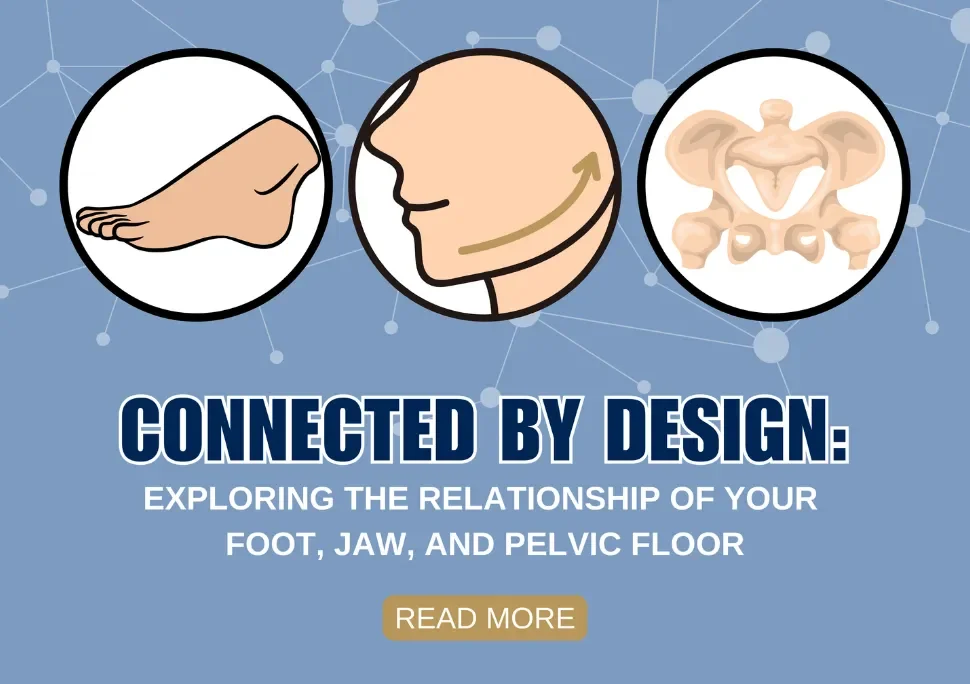Connected by Design: Exploring the Relationship of Your Foot, Jaw, and Pelvic Floor
This might come as a surprise, but your jaw and your feet both have connections with your pelvic floor! Today we will explore some of the ways that these areas interact with each other. Let’s start by discussing the feet!
Our feet can affect our pelvic floor in a number of ways, such as through biomechanical changes, shock absorption, fascial connections, and brain mapping. Since our foot and ankle position influences muscle activation up our legs, it can then have an effect on our pelvic floor. Ultimately, our foot position results in pelvic position changes as well as impacting pelvic floor muscle activation. In addition, both our feet and our pelvic floor are shock absorbers. They help transfer load and absorb impact during activity, like jumping, so that all of the force of the activity does not go to the knees or back. The connective tissue that makes up the layers of soft tissue between your skin and muscles is called fascia. It helps to keep muscles, nerves, and other vessels in place, and is surrounded by a lubricating fluid to help your body move with ease. There are fascial connections all throughout your body, including from the foot to the spine, which impacts your pelvis and pelvic floor! Finally, when it comes to the map in our brain where information from the body is processed, our genitals and feet are right next to each other! This means that the motor and sensory information from both is processed close together, creating another link between the foot and pelvic floor. Assessing foot and ankle position can be helpful when determining strategies to address pelvic floor muscle control, and a pelvic floor physical therapist is a great resource to help with this! They can assess your body as a whole to help you get back to enjoying life without limitations!
Now let’s talk about how your jaw and pelvic floor can also be closely linked! These connections begin forming during early embryonic development, and the connection remains due to fascial connections and dural tubing surrounding the spinal cord. Around 15 days of embryonic development, two depressions form. One becomes the opening to the mouth, and the other becomes the opening to the urethra, anus, and reproductive organs as the spine develops. In addition, the dural tube encloses the spinal cord and runs from brain to tailbone. Tightness or restrictions along the tube can impact the pelvic floor through neural tension. Similar to our feet, there is also a deep fascial connection between the jaw and pelvic floor that runs along the front of the body. The muscles and fascia of your deep neck and jaw are part of your intrinsic core system, and they contribute to deep stability! The last connection may be the least surprising to readers, and that is stress. Stress can often play a major role in increased jaw clenching or jaw tension. This may or may not result in jaw pain or temporomandibular joint (TMJ) dysfunction. This increased tension in the jaw can increase the tension in the deep frontal fascial line that connects to the pelvis. This, or a habit of clenching both the jaw and pelvic floor in response to stress can create overactivity in the pelvic floor muscles. This can present in a variety of ways such as pelvic pain, constipation, urinary leakage, etc. In conclusion, stress and daily holding patterns in the jaw can tension the fascial connections and create overactivity of the pelvic floor muscles. Now is a great time to check in and unclench your jaw!
Let’s practice together!
Relax your jaw
Let your shoulders fall away from your ears
Take a deep breath in through your nose and exhale out through your mouth
Lightly touch your tip of your tongue to the roof of your mouth, just behind your front teeth, and hold it here while you open and close your mouth 6 times
Tilt one ear towards your shoulder on the same side, letting your neck gently stretch. Breathe here for 20-30 seconds. Repeat on the other side.
The trained pelvic floor physical therapists here at Treasure Valley Pelvic Health are here to support you in living a life unlimited! Your PT will complete a full assessment, ensuring all elements contributing to your symptoms are addressed. Reach out to us or a pelvic floor PT in your community to take steps towards feeling your best!
In Health,
The Team at Treasure Valley Pelvic Health

